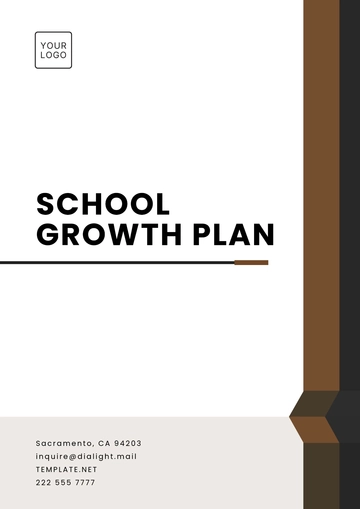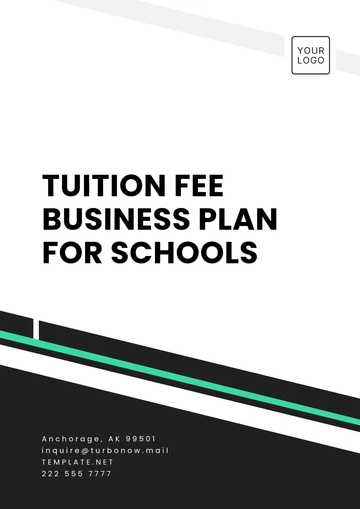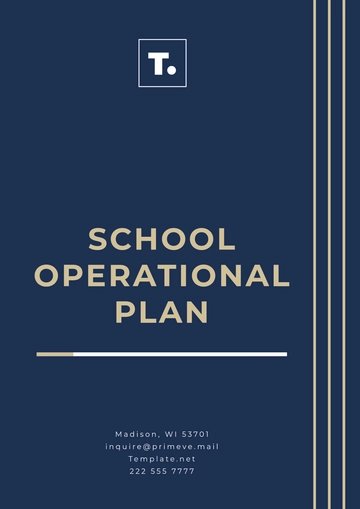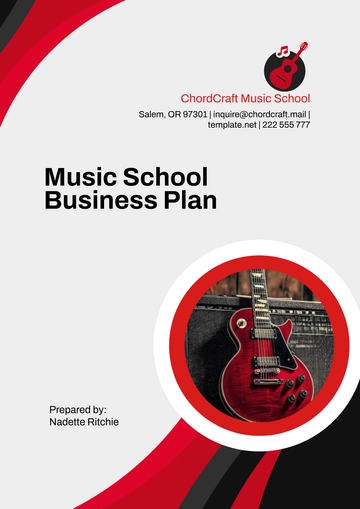Free School Business Plan for Investors

Executive Summary
Business Name: [Your Company Name]
Location: [Your Company Address]
Type of School: Private K-12 Tech-Focused School
Mission Statement:
[Your Company Name] is dedicated to cultivating a new generation of forward-thinking, tech-savvy leaders who will thrive in the digital age. By integrating cutting-edge technologies, such as AI, robotics, and virtual reality, with an inquiry-based curriculum, we aim to empower students to solve real-world challenges and innovate for the future.Vision Statement:
To become the most innovative educational institution in the world by 2050, where every student graduates not only with academic excellence but also with the skills and mindset needed to lead in the ever-evolving global economy.Objectives:
Launch the first campus in San Francisco by June 2050.
Enroll 200 students in Year 1 and grow to 1,000 students by Year 3.
Achieve an 80% graduation rate in the first 5 years.
Implement AI-powered personalized learning programs to support each student's unique needs by December 2052.
Business Description
Overview of the School:
[Your Company Name] is a private K-12 school designed to foster a future-ready workforce by offering an immersive, technology-driven learning environment. Our school will focus on STEM education, coding, robotics, AI, and virtual reality, alongside traditional subjects, to prepare students for careers in emerging technologies and industries.Educational Approach:
The academy will feature a hybrid learning model, combining in-person education with virtual classrooms, leveraging AI tutors and personalized learning algorithms to adapt lessons based on each student’s progress. Additionally, project-based learning will be central to our approach, emphasizing real-world problem-solving through technology.Target Market:
Students: Children aged 5-18, from families seeking an advanced educational experience with an emphasis on technology and innovation.
Geographic Target: Initially based in the San Francisco Bay Area, with plans to expand into other major U.S. cities (e.g., Los Angeles, New York, Miami) by 2055.
Market Need:
As the world accelerates into an AI-powered future, traditional education systems are often unable to keep pace with the rapid advancements in technology. Parents and students are increasingly seeking specialized schools that blend academics with technological fluency. By 2050, demand for high-tech, hands-on learning environments will be at an all-time high.Unique Selling Proposition (USP):
[Your Company Name] offers an unprecedented approach by integrating AI learning assistants and virtual reality classrooms into everyday lessons. With a curriculum designed in collaboration with industry leaders, students will gain firsthand experience working with the technologies of tomorrow, such as autonomous systems, blockchain, and quantum computing.
Market Analysis
Industry Overview:
The global education market is expected to grow significantly, with an emphasis on EdTech and personalized learning platforms. By 2050, the educational landscape will be dominated by online and hybrid schools, with virtual reality and AI as integral components of the learning experience.Target Audience:
Affluent Families: Parents who prioritize high-quality, future-focused education for their children.
Tech-Savvy Families: Families who are passionate about incorporating technology into their children’s learning.
Corporate Partners: Tech companies interested in collaborating with educational institutions to foster innovation in the workforce.
Competitive Analysis:
[Your Company Name] will face competition from established private schools, charter schools, and online education providers. However, we differentiate ourselves through our comprehensive focus on technology, personalized AI-driven learning paths, and real-world industry collaborations, making us a pioneer in the educational sector.Marketing Strategy:
Digital Campaigns: Targeted ads and social media engagement focused on the San Francisco Bay Area.
Tech Industry Partnerships: Collaborations with tech giants such as Google, Apple, and Tesla, who will sponsor events and offer internships.
Referral Programs: Engaging existing families and students to refer others with incentives such as discounted tuition for subsequent years.
Operations Plan
Location and Facilities:
[Your Company Name] will operate from a 50,000 sq ft campus in San Francisco, designed to house state-of-the-art classrooms, VR labs, robotics labs, and collaborative spaces. The school will incorporate green building practices to ensure sustainability.
Staffing:
We will hire a team of highly skilled educators proficient in STEM fields, including AI experts, robotics instructors, and VR specialists. By 2050, we plan to employ 50 teachers, supported by 15 administrators and 30 technical staff.
Curriculum Design:
Students will receive a rigorous education in traditional subjects, alongside specialized courses in:
Coding and programming languages (e.g., Python, JavaScript, Solidity).
Robotics, automation, and AI.
Virtual and augmented reality integration.
Ethical considerations in technology and AI.
Technology and Infrastructure:
AI Learning Assistants: Customized learning experiences based on student needs.
Virtual Reality Classrooms: History, science, and global studies immersions.
Data-Driven Progress Tracking: Real-time analytics to monitor and enhance student performance.
School Calendar:
The academic year will follow a September to June schedule, with optional summer enrichment programs focusing on coding boot camps and technology workshops.
Management and Organization
Ownership Structure:
[Your Company Name] will operate as a for-profit private school under the ownership of a private education group (LLC).
Founders and Management Team:
Dr. Elena Wong (Founder & CEO): PhD in Educational Technology with 15 years of experience in tech and education.
Mark Jenkins (Head of Curriculum Development): Former education director at a global EdTech firm.
Sarah Patel (Chief Operating Officer): Former COO at a leading private school network in California.
Advisors and Partnerships:
Partnership with MIT’s Media Lab for curriculum development.
Advisory board from leaders in the AI and tech industries, including Elon Musk (Tesla, SpaceX) and Sundar Pichai (Google).
Financial Plan
Startup Costs:
Initial investment for building and operations:
Land and Construction: $25 million
Curriculum Development: $2 million
Technology Infrastructure: $5 million
Marketing and Admissions: $1 million
Total Initial Investment: $33 million
Revenue Model:
Tuition Fees: Estimated at $30,000 per student per year.
Corporate Sponsorships: Partnerships with tech companies for lab naming rights and student internship programs.
Workshops and Events: Hosting paid workshops, coding boot camps, and hackathons.
Financial Projections:
Year 1: Enrollment of 200 students, generating $6 million in tuition revenue.
Year 3: Expansion to 1,000 students, generating $30 million in tuition revenue.
Year 5: Profitability expected with $50 million in total revenue from tuition, sponsorships, and events.
Risk Analysis and Mitigation
Risks:
Economic downturns: Economic instability could affect enrollment and tuition collection.
Technology disruptions: Rapid advancements in technology might require frequent curriculum updates.
Mitigation Strategies:
Diversify revenue streams through corporate sponsorships and tech partnerships.
Implement a continuous curriculum revision process to stay ahead of technological trends.
Exit Strategy
Exit Plan for Investors:
Investors will be offered an exit via a sale to a larger educational network or a public offering as the school grows.
Projected Exit Year: 2060
Appendices
Supporting Documents:
Architectural plans for the campus.
Letters of intent from Google, Tesla, and MIT.
Sample curriculum for Year 1.
- 100% Customizable, free editor
- Access 1 Million+ Templates, photo’s & graphics
- Download or share as a template
- Click and replace photos, graphics, text, backgrounds
- Resize, crop, AI write & more
- Access advanced editor
Impress stakeholders with Template.net’s School Business Plan for Investors Template. Customizable and editable, it emphasizes financial strategies, objectives, and operational details. Editable in our AI Editor Tool, this template ensures clarity and professionalism. Download now to secure investor confidence.
You may also like
- One Page Business Plan
- Coffee Shop Business Plan
- Restaurant Business Plan
- Food Business Plan
- Real Estate Business Plan
- Executive Summary Business Plan
- Cover Page Business Plan
- Nonprofit Business Plan
- Daycare Business Plan
- Construction Business Plan
- Startup Business Plan
- Medical Business Plan
- Bakery Business Plan
- Service Plan
- Hotel Business Plan
- Catering Business Plan
- School Business Plan
- Healthcare Business Plan
- Transportation Plan
- Sports Plan
- Car Wash Business Plan
- Salon Business Plan
- Clothing Business Plan
- Farming Business Plan
- Boutique Plan





























